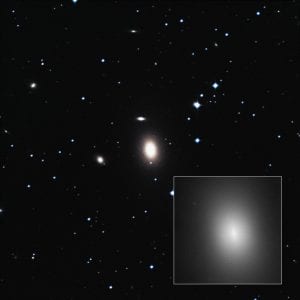
Pictured in the center is the NGC 1600 galaxy. (Source: Wikimedia Commons, Credit: ESA/Hubble).
Astronomers at UC Berkeley have discovered a supermassive black hole in an unusual location. The black hole is approximately seventeen billion times more massive than the sun and was found in a relatively empty region of the galaxy NGC 1600 (1).
Black holes are essentially regions of space with such strong gravity that nothing can escape: not even light. A black hole can only grow bigger when something falls into it, so it surprising to see such a massive one so far away from any sources of new matter. In fact, until now, supermassive black holes (black holes with more than ten billion times the mass of the Sun) have only been found in the densely populated centers of large galaxies (1).
Chung-Pei Ma, the leader of the MASSIVE survey that found NGC 1600, believes that the black hole may be a dormant quasar (1). Quasars, or quasi-stellar radio sources, are very old objects created near the birth of the universe that, as the name suggests, emit large amounts of radio waves (2). If the NGC 1600 black hole were a quasar, then it would have formed during a period of time when unbound gas was freely available. It would have been able to absorb some of this gas before it became isolated, which would explain its supermassive size (3).
There is also evidence that the black hole is part of a binary system, in which two different black holes orbit one another. Because it is difficult for stars to form stable orbits around a binary system of black holes, one would expect to find few stars near such a system (1). Indeed, the center of NGC 1600 is sparsely populated (3).
The discovery of NGC 1600 suggests that astronomers may have to reevaluate the ways in which they search for black holes. Currently, astronomers are focusing their efforts on regions of space with a lot of matter, such as galactic cores. However, this new find demonstrates the importance of a broader, systematic search, as this isolated black hole may just be “the tip of the iceberg.” Furthermore, the discovery suggests that pockets of seemingly empty space may also be likely to harbor pairs of black holes (1).
References:
(1) Sanders, R. (2016, April 06). Supermassive black holes may be lurking everywhere in the universe. Retrieved April 10, 2016, from http://news.berkeley.edu/2016/04/06/supermassive-black-holes-may-be-lurking-everywhere-in-the-universe/
(2) Simonetti, J. (n.d.). Frequently Asked Questions About Quasars. Retrieved April 10, 2016, from http://www.phys.vt.edu/~jhs/faq/quasars.html#q1
(3) Thomas, J., Ma, C., Mcconnell, N. J., Greene, J. E., Blakeslee, J. P., & Janish, R. (2016). A 17-billion-solar-mass black hole in a group galaxy with a diffuse core. Nature. doi:10.1038/nature17197